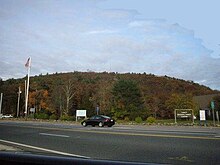Great Blue Hill eruption prank
The Great Blue Hill eruption prank (German: 'Great-Blue-Hill-Ausbruchsstreich') was an April Fool's joke that led to a mass panic in Milton , Massachusetts on April 1, 1980 .
news
The evening news broadcast at 6:00 p.m. on the former Boston television station WNAC-TV , which belongs to RKO General , ended the broadcast with a “News Bulletin” about the volcanic eruption of the Great, about 10 miles south of Boston Blue Hill , which has no volcanic origin, reports. Ash and lava were reported to be pouring over adjacent homes in Milton. The report pointed to a connection with the previous earthquake and volcanic activity on Mount St. Helens , which had taken place since mid-March 1980 and had already led to earth and ice avalanches that later culminated in the eruption in May 1980 . Geological faults have also been reported across the country, including tidal waves in the Great Lakes and volcanic eruptions in Massachusetts. The report was accompanied by pictures allegedly taken on Great Blue Hill, but taken from Mount St. Helens and showing the activities of March 27th. It was also reported that President Jimmy Carter had expressed concern about the event and that Massachusetts Governor Edward J. King considered the situation "serious". At the end of the program, the reporter John Henning held a sign in the camera that read: "April Fool".
The show's reporters, Mary Richardson and John Henning, made a few jokes about this April Fool's joke at the end of the show, but the actual pictures were also unknown to them until then. Only a few employees at the station were aware of the content of the program and Henning later said: “Both Mary and I recognized when we saw it that it was missing the target. It wasn't like an April Fool's joke should have been done. It was too plastic. "
Reactions
Many of the residents who had seen the program no longer waited for the program to end, but tried to get to safety immediately. The Milton Police Department and Massachusetts Department of Civil Defense were inundated with calls as residents tried to determine safe evacuation routes. Many others got straight into their cars and left the area.
The broadcaster WNAC-TV received calls from dozens of angry viewers and apologized to the residents on the news program at 11 p.m. for the April Fool's joke and the panic it caused. The Federal Communications Commission opened an investigation into the incidents. Within 24 hours of the broadcast, the show's producer, Homer R. Cilley Jr. (1946–2005), was fired by the broadcaster's executive director Robert Williamson. The reason given for the dismissal was “an enormous lack of news judgment” (German: “an enormous lack of news judgment”). The use of archive material without marking it as such also violated the rules of the Federal Communications Commission and the broadcaster. Cilley himself accepted that and took responsibility with the words: “I did it, it was my responsibility, and it's something I will have to bear alone” (German: 'I did it, it was my responsibility and it is something that I have to endure alone ').
reception
On April 2, 1980, the April Fool's joke and its aftermath gained national fame through the cover story in The Boston Globe . In the years that followed, the media referred to the report on the volcanic eruption, which was listed as one of the most unsuccessful April Fools jokes that "backfired dramatically and catastrophically". Among other things, he was still referred to in 2015 and 2016 as the "infamous April Fool's joke" and "one of the most ridiculous news carvers in the history of American television".
literature
- Terry Ann Knopf: The Golden Age of Boston Television . University Press of New England, 2017, ISBN 978-1611689044 , p. 84
- Av Westin: Newswatch: How TV Decides the News . Simon and Schuster, New York 1983, ISBN 978-0671421809 , p. 219
- Alex Boese: The Museum of Hoaxes . Dutton, 2002, ISBN 978-0525946786 , p. 165
Individual evidence
- ↑ a b The Milwaukee Journal of March 30, 1984 - Google News archive search. In: google.com. news.google.com, accessed March 16, 2019 .
- ↑ a b True Tales from Canton's Past: Breaking News of March 31, 2016. In: thecantoncitizen.com. Retrieved March 16, 2019 (American English).
- ↑ a b Daily News of April 3, 1980 - Google News archive search. In: google.com. news.google.com, accessed March 16, 2019 .
- ^ TV station fires producer for airing April-fool prank . In: Christian Science Monitor . 1980, ISSN 0882-7729 ( csmonitor.com ).
- ↑ Terry Ann Knopf: The Golden Age of Boston Television . University Press of New England, 2017, ISBN 978-1611689044 , p. 84
- ^ The Boston Globe: April Fools' Day pranks: The good, the bad, and the ugly, March 28, 2015. Retrieved March 23, 2019
- ↑ Reader's Digest: April 13, Fool's Pranks That Went Horribly Wrong, March 29, 2018. Retrieved March 23, 2019
- ^ The Telegraph: When April Fools' Day pranks go disastrously wrong, April 1, 2017. Retrieved March 23, 2019
- ^ Vox: April 5 Fools' Day pranks that backfired disastrously dated April 1, 2015. Retrieved March 23, 2019
- ↑ The Columbian: Off beat: April Fool's joke had people blowing their tops weeks before mountain did on May 24, 2010. Retrieved March 23, 2019
- ↑ American Scientist: A Fool's Errand: Writing Science Spoofs to Enthrall, Not Annoy, April 2, 2015. Retrieved March 23, 2019
